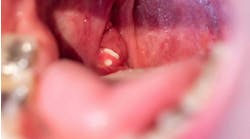by Dianne Glasscoe
Dear Dianne,
I graduated from dental hygiene school in 1992 and went to work in a wonderful general practice. Last year, my husband was transferred to another state, so we had to move. To receive my license in the new state, I had to take an exam covering infection control and jurisprudence, which I passed.
Currently, I work in a local general practice, but I am seriously considering leaving. The reason is that the infection control standards practiced in the office by other staff members are sloppy and out-of-date. There is one chairside assistant who never uses any barriers on overhead light handles, chairs, bracket trays, X-ray tubeheads, or air/water syringes. Her practice is to wipe everything with a damp 4x4 sponge. Handpiece sterilization is haphazard at best. Sometimes it happens, sometimes it doesn't. I have observed her carrying patient charts to the front desk with contaminated gloves. Also, she wastes treatment gloves by refusing to wear utility gloves for clean-up purposes.
When I came to work here, I asked for plastic barriers for all of the above-mentioned items. The assistant ordered the necessary items for me but made it plain that she did not feel it was necessary.
I try to follow good asepsis procedures, because I would not want to be responsible for passing disease-causing microorganisms from one patient to another. However, the assistant continues to show contempt for my infection control procedures.
The bottom line is that I would not feel comfortable having dentistry done in this office, nor would I want my family to be treated in an environment that I feel is unsafe.
How can I make the assistant see that, instead of criticizing me, she needs to bring her own practices up to the correct standards?
Keeping it Clean in Connecticut
Dear Keeping,
It sounds to me like this assistant is stuck back in the 1970s, because wiping everything down with an alcohol sponge was standard protocol back then. I shudder to think of some of the infection control methods we used in those days. I can even remember when we used to rinse out saliva ejectors, soak them overnight, and reuse them!
Back in those days of innocence/ignorance, we did not know about HIV and many emerging diseases spread through the sharing of intravenous needles, blood transfusions, and/or sexual intercourse. Our knowledge about disease transmission and cross-contamination was limited, and there is no telling how many patients got colds, etc. after a dental visit. It's a wonder that many more dental practitioners and patients did not get serious illnesses. When I graduated from hygiene school in 1978, we did not wear gloves unless we had a cut or open wound on our hands or if our patient was ill. Eye protection and masks were optional.
When the human immunodeficiency virus was identified just a few years later, everything changed! This virus was like no other in its ability to destroy the host immunity and cause a slow, painful death. I remember when gloves, masks, and eye protection became mandatory. My boss, who was a 25-year veteran of dentistry, jokingly called me the "masked wonder." It was difficult for him to change his old routine and get used to the burden of the new infection control protocol.
Standards among individual offices continue to evolve. Barriers, which afford the best infection control, have been met with more resistance than spraying and wiping. I'm still amazed when I see clinicians going to the trouble of wiping down an operatory chair in between patients. Using a plastic chair cover negates wiping and preserves the upholstery from the damaging effects of chemicals.
The same is true for bracket trays and holders for the air/water syringe, saliva ejector, and handpiece. Furthermore, if the handpiece is not heat sterilized after every use, it is supposed to be covered with a clean plastic barrier. Wiping or spraying is not sufficient to thoroughly rid a handpiece of pathogens. Hygienists who merely wipe the handpiece down between patients should ask themselves this question: Would I want to be the last patient of the day and have a handpiece that has been in the mouths of nine other people — and not sterilized — used on me? I didn't think so! And while it is true that handpiece barriers are a burden to use, they offer the best guard against cross-contamination outside of heat sterilization.
One thing that bothers me is that your doctor has not taken the lead in keeping current infection control protocols in place. My guess is that this doctor and assistant have been practicing dentistry for a long time and have simply not kept up with all the changes through the years. Another possibility is that the assistant was trained by someone who was not up-to-date on current protocol. Unless the assistant is certified, she is not required to take continuing education.
You asked how you can make her see that she is grossly behind the times with her infection control methods. My short answer to this is that you can't make her see or do anything. The problem is that needed changes in infection control protocol must first be accepted and embraced by the doctor. With that in mind, you can offer to be the infection control facilitator for your practice.
Every dental office has the responsibility to protect patients and staff members from the potential spread of disease. Knowing and keeping current with emerging infection control procedures helps insure that patients and staff members will be protected.
It has long been held that the best learning takes place when the participants take an active part in the learning process. Therefore, this guide has been developed to help dental practices conduct their own yearly infection control update with all staff members participating in the discussion.
The first step
The first essential element is providing staff members with a resource to obtain the information they need. I highly recommend the book, Infection Control and Management of Hazardous Materials for the Dental Team, by Chris Miller, PhD, and Charles John Palenik, PhD, (Second edition, Mosby, Inc., copyright 1998). Another good resource is Safety Standards and Infection Control for Dental Assistants by E. Dietz and R. Runnells (Independence, KY: Delmar Learning: 2001). I also recommend that the office join the organization OSAP (Office Safety and Asepsis Procedures Research Foundation, www.osap.org). This organization provides educational conferences, recommendations, books, brochures, documents, audiotapes, newsletters, updates, and member support services (800-298-OSAP).
The OSHA standard requires that the person conducting the training be knowledgeable about bloodborne pathogens and about infection control procedures related to the dental workplace. It is recommended that one staff member be placed in charge of infection control procedures in the office and planning the meeting agenda. This staff member must be familiar with clinical procedures. Therefore, a dentist, a registered dental hygienist, or certified chairside assistant would function best in this capacity. Since this staff member will have to spend time monitoring OSAP newsletters, keep the office updated on changes, and plan the agenda for the yearly meeting, he or she should be compensated appropriately for the extra effort.
According to the aforementioned textbook authors, "Records documenting that employees covered under the standard received the required training must contain: (1) dates of the training sessions, (2) contents or summary of the training, (3) names and qualifications of the persons conducting the training, and (4) names and job titles of all persons attending the training sessions. The records are to be kept for three years from the date on which the training occurred. OSHA compliance officers will verify the competency of the trainer based on the completion of specialized courses, degree programs, or work experiences ..."
Some offices choose to record the session on cassette tape for verification of the meeting. Otherwise, a recording secretary should take notes during the meeting.
Conducting an annual OSHA review of infection control and office safety can be an enjoyable and informative time for all staff members. These meetings tend to keep everyone aware of the potential hazards and ways to avoid unfortunate, even life-threatening, incidents. As health professionals, we are expected to know all the pertinent data regarding infection control. However, research brings change and new modalities. The yearly meetings help us "sharpen the saw." If the meetings are well planned and approached with the proper attitude, you and other staff members will actually look forward to your in-office session.
One note of warning — do not expect huge changes to take place overnight. Everybody comes to feel comfortable in a certain routine, and upsetting that routine is painful at first. If small changes can be implemented over time, the changes are more palatable.
The most telling part of your letter is where you state you would not feel comfortable having your family treated there. With your help, I certainly hope that feeling will change! With your doctor's approval, you should be able to improve the overall infection control protocol, thereby making the office a safer place for patients and staff members. That's a worthy goal!
Best wishes,
Dianne
Here is an example of a well-organized agenda:
1. Epidemiology (telephone the local health department to get current statistics for your county)
• Hepatitis B
• Hepatitis Non-A-B
• Hepatitis C
• B carriers
• Gonorrhea
• Syphilis
• Tuberculosis
• HIV
• AIDS
• Cumulative HIV caseload
2. Modes of HBV and HIV transmission
3. Methods to control exposure
• Universal precautions
• Engineering controls
• Work practice controls
• Personal protective equipment
4. HBV vaccination
5. Post exposure evaluation and follow-up
6. Infectious waste disposal
7. Asepsis
• Housekeeping
• Instruments
• X-ray/darkroom
8. Laundry practices
9. Bloodborne pathogens standard
10. Office protocol
• Fire escape
• Tornado/severe weather
• OSHA inspection
• EMS activation
• Emergencies
11. Hazard communication
12. Ergonomics
Each staff member should be assigned one or more areas to present. The length of the training session is determined by how much material will be presented. Some topics require more time than others. However, requesting that each topic be limited to 10 minutes allows the meeting to progress smoothly and not become bogged down. At this rate, the meeting should be about two hours long. Certainly, if productive discussion ensues, the meeting can be continued at a later session.
The sample agenda provided is not an all-encompassing format. There are other areas that could be explored in an annual training session as well, such as CDC guidelines, MSDS sheets, sterilization monitoring, chemicals used in the dental office, etc.
Most one-doctor dental offices have a small number of staff members. Therefore, two or three local offices may want to come together for conducting their training session. The topics to be covered in the meeting can be assigned several weeks before the meeting so nobody will feel overwhelmed at having to present a large amount of information. This meeting should be conducted on office time with staff compensation.
(Author's note: This guide was written in conjunction with Kristie Bouldin, RDH, from Trinity, N.C. Kristie is a full-time practicing hygienist and infection control coordinator in the practice of Smith, Lanning, Bundy, and Miller in Thomasville, N.C.)
Dianne D. Glasscoe, RDH, BS, is a professional speaker, writer, and consultant to dental practices across the United States. She is CEO of Professional Dental Management, based in Frederick, Md. To contact Glasscoe for speaking or consulting, call (301) 874-5240 or email [email protected]. Visit her Web site at www.pro fessionaldentalmgmt.com.





